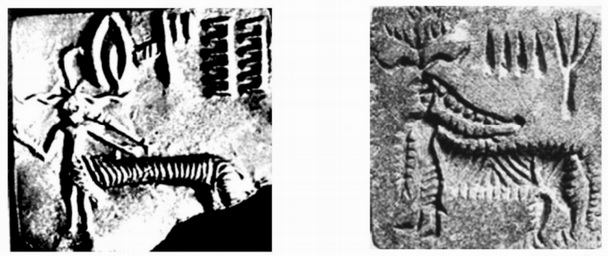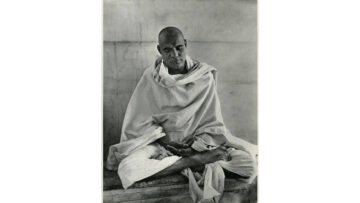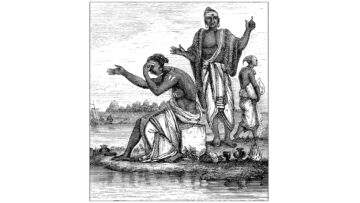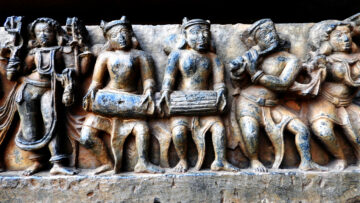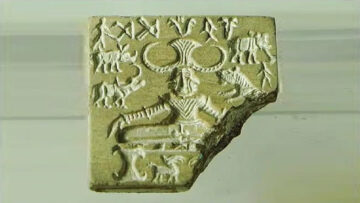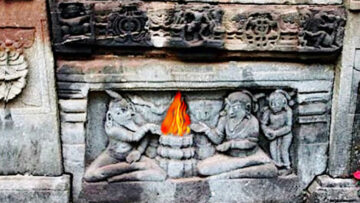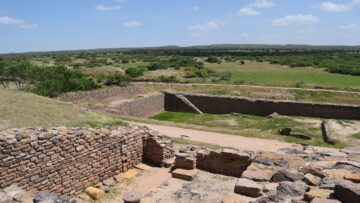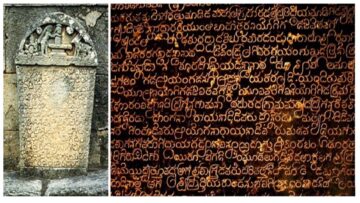Abstract:
Interpreting Indus Seals by deploying the literary sources, social and cultural practices that prevailed in those times, unearths information hidden in the seals. Some of the Indus seals show a peculiar picture of a man merging with a tiger. The man is adorned with the animal skin and has long matted hair depicted horizontally like a snake. His head is decorated with a turban on which are the decorations of twigs and flowers. The extended portion of the turban is held in the left hand. The merging with animal body is depicted with the front two feet like human and the back ones like tiger’s. The arms are serrated and depicted to be holding a long Stick, Shula or lance in the right hand. These characters correlate closely with the Rig Vedic description of a group of ascetics of tribal origin termed Vratyas or Kesins who are described in the 10th mandala (Hymns of Rig Veda, 10.136.1-7 (Griffith, 1973). Since the depiction of vratyas is seen in the Indus seals, as described in Vedas, one can say that Vratyas lived either before or during the time of Indus civilisation.
This paper attempts to trace the term Vratyas described in Vedas and how well the vratyas and Vratya pati – Rudra is mirrored in the Indus seals. My analysis of the 4 seals here, show a strong correlation to Vedic practices that were followed in Indus period.
Type and Theme of Indus Seals
A brief Description of Seals:
The Indus / Harappan Seals, many as tiny as 3cms / 3.5cms, and weighing nine to ten grams approximately were discovered in the vast expanse of Indus civilization sites of Harappa – Mohenjo-Daro and north Western parts of India, were unearthed in the excavations of 1927-1931. These seals with finely executed carvings are the archaeological proof of the civilization that existed around 2300 B.C.E. Most of the Indus Seals are made of a type of Soft Stone called Steatite, a type of white or greenish rock, composed of talc and resistant to high temperatures. The softness of this variety of soap stone when freshly cut probably made it popular for carving artefacts, seals with pictures and Symbols.
The scholars are more inclined to accept the date of C-14 test and have fixed the lower date to be 1500 B.C.E. It is also interesting to note that the date of Rig Veda and the other three Vedas is said to be compiled approximately in 1400 B.C.E. in its evolved form. The Indus seals can be thus considered as the archaeological proof of the civilization of Vedic period. Some seals depict the Symbols of bird altar as well as the three sacrificial altars as Symbols inscribed that looks like Script, Support the view that the information contained in the Seals are related to fire altars of yajna. The social pattern of life and Vedic rituals that were in vogue during the Vedic and post Vedic period could be considered as the primary tools to the study of seals. An insight into the Vedic rituals appears essential for a proper understanding of Vedic as well as Indus civilisation that existed at least 3000 years ago.
The social order and the concept of God, their role as protectors and giver of wealth, the rituals adopted to please these deities, the abode of dead Pitrus (fore fathers), the demons who bothered humans in many ways, all aspects that were probably part of the pre-Rig Veda civilisation, got expressed in Rig Veda in a poetic form. Many seals depicted like an action tableau can be related to the legends and episodes of the Vedas. The social life pattern of the ancient Vedic civilisation can be seen depicted in the Indus seals in which the information is documented in Symbol form for reasons – the script of language had not yet evolved. The contents of the literary creations were translated as archaeological proofs of seals over a period in the post Vedic period. The seals reflect the spirit of an age in which the intellectual activity was concentrated on the yajna and sacrifices.
The Two Types of Seals – Vidhi and Arthavada:
The Indus Seals are mainly of two types. Firstly, the ones with a single horned bull or an animal representation like rhino, bull or an elephant along with five to ten Symbols inscribed. Secondly, some are the pictorial presentation of an episode with human figures with or without Symbols inscribed. The reason for the difference in representation could be understood when the two types of explanations of the rituals, as explained in the post Vedic literature, the Brahmana text are considered.
According to Arthur A Macdonell in “History of Sanskrit Literature”, “The period in which the Vedic Samhitas arose was followed by one which produced a different type of literature, a theological treatise called Brahmanas.” Brahmanas are the ritual text-books on the details of sacrifice or Yajna, explained in a prose order for easy understanding. In other words, the name ‘Brahmana’ means the explanation of a ritual by a learned priest for those who were familiar with the sacrifice procedures. The description, though not exhaustive gave the outlines. Another Set of Work regarded as auxiliary and the six limbs of the Vedas called Vedangas were made in the post Vedic period to help in the proper phonetical and ritual understanding of Vedas. One of the Vedangas was the Kalpa, which also dealt with the procedural percept associated with performance like how and when the rituals of sacrifices are performed. The figures and the inscriptions on the seals when analyzed appeared to have the contents of Brahmana texts; hence, may belong to a period later to Brahmana text compilation. An attempt was made in seals for the brief coded form of contents of Vedas. Though the Brahmana texts deal with the following six topics, the first two were considered as the main type of explaining a ritual. The Six Categories were — Vidhi, Arthavada, Ninda, Prashansha, Purakalpa and Parakriti. Vidhi-dealt with the rules and injunctions of a yajna ritual Arthavada — dealt with explicatory System.
The Vidhi type of explanations usually come with the picture of a single horned bull or an animal along with 5-6 symbols in a seal. This part sets forth the various details relating to a sacrifice like proper time, the place for sacrifice, the rite of initiation, the priests, the sacred fires, the divinities, the oblations offered to them, the utensils and other materials used and the procedure of reciting Mantras and the metre of it, the Chandas. The other details were conveyed symbolically in the inscription part. The Vidhi consists of a rule of ritualistic procedure, or commandment- a sacred precept. (This type of seals is not a part of this article, but are discussed in my E book “Symbolography in Indus Seals”, Rekha Rao).
Arthavada comprises the numerous explanatory remarks on the meaning of Mantras of particular rites and are more to illustrate the vidhi – the rules of a Sacrifice and picturise a Sacrifice. In Arthavada, the ancient legends, most of which had the conflicts between Gods and demons as their central theme and narrate how Gods became powerful enough to vanquish the demons. Such topics got picturised in the arthavada set of Seals.
Arthavada seals also depict the variations in costume and the ornaments that adorn the figures because they were the faithful representation of the descriptions given in Vedas. The figures of tribal origin wearing the costume of an animal skin around the waist and an elaborate head dress are shown in contrast to the hair style, tied into a bun of the priestly class. The depictions of human and animal form, Complete in physical structure, are full of action and expression, presented like a perfect picture in two-inch square seals. The thoughts have precision in their execution. In addition, the tools used being sophisticated contributed to the precision and complexity of the seals. The caliber of narration of episodes with illustrations in the Indus seals can be compared to miniature paintings in its Sophistication. The Symbols and motifs have been used extensively to convey the vast information of rituals.
Who were Vratyas?
Regarding the literary evidences for vratyas, the Rig Veda, generally, employs the term Vratya or Kesins to denote breakaway group or an inimical horde, living in temporary settlements. Satha Rudriya of YajurVeda, the Vratya Kanda (15th kanda) of AtharvaVeda, Tandya (24-18) and Jaiminiya Brahmana (2:222) introduces Vratyas as nomadic ascetics roaming about themselves in an intoxicated State. The Tandya; however, addresses them as divine – Vratyas (Daiva Vai Vratyah). The Vajasaneyi Samhita refers to them as physicians and as guardians of truth. They seem to have been a community of ascetics living under a set of Strange religious vows called Vrata, and hence the name Vratya.
The Vratyas worshipped elements of nature like Agni, Vayu, and Varuna; however, Rudra was their preferred deity. Some of them lived alone and some in groups, away from populated areas, following their own cult-rules and practises. They were the Wandering Seekers, drifted everywhere; roamed from the Indus valley to banks of the Ganga. They were non-conformists and rejected the validity of the Vedas and their rituals. They were an atrociously heterogeneous Community; and moved like rebels in a group of thirty-three, with a leader. The amazing community of the Vratyas included talented ones like magicians, medicine men, singers, mystics, materialists, mendicants, roaming warriors, mercenaries, poison eaters, libidinous pleasure seekers and wandering Swarm of austere ascetics. Some of them were violent and some others were refined and austere.
The Dress Code of Vratyas:
The Vratyas were wanderers (indicated in the Seal by a fearless animal, attached to human body). RigVeda (10.136.1-7) explains about the ascetics called Kesins-(the other term for vratyas) who were wearers of long loose hair or locks of hair that were matted. Etymologically Kesin mean – a lion, is from the root word Keshara-meaning the mane of a lion, with luxuriant hair, also described as the best, excellent or prominent of a class. They were Muni or ascetics, who worshiped elements of nature like Sun, air, moisture and so on. They always loved to be in a state of ecstasy and never wore any girdle on waist or Yajnopavita like a dvija or brahmin class. They were the sons and descendants of Sage Vata Rashana – which meant wind girdled or moving like wind in life style, following their own vratas and hence, called Vratyas. Rig Veda (Griffith) 10.136.1-7says about Vratyas:
“He (Kesins) with the long loose locks supports Agni and moisture, has all sky to look upon (meaning free) with long hair that is called this light
The munis girdled with wind, wore garments Soiled of yellow hue (means the skin of animals). They following the wind’s Swift course go where the Gods have gone before.
Transported with munihood mortal men, behold our natural bodies and no more (were naked).The steed of Vata, Vayu’s friend, the Muni, by God’s impelled, in both the oceans hath his home in eastern and in Western Sea.”
The address of sea may be indicative of the mighty rivers Ganga and Sindhu.
Vratyas were distinguished by their black turbans (Krishnam Ushnisham Dharayanti) worn in a slanting manner, displaying long matted hair (Kesi). This is depicted in seals as long Snake like head decoration. Atop was the buds of plants attached; a set of round ornaments for the ears (Pravartau). Varieties of neck ornaments were hanging by the neck across the chest with rows of long necklaces of Strange beads (mani) Swinging. Two (dvi) deer-skins were tied together for lower garment, (displayed as a long piece of skin tied around the waist, that was extracted from the animal), and sandals for the feet (Upanahau). They carried a lance called Pra-toda. A white blanket was thrown across the shoulders.
The Vratyas spoke the dialect of Prachya, the source of the languages of ancient Eastern India. It is also said; the Vratyas also spoke the language of the initiated (Dikshita – vac), though not themselves initiated (Adikshita), however, also used that which is easy to utter (a- durukta) and difficult to utter. (Panchavinsa Brahmana 17.1.9). This may mean that the Vratyas were familiar and comfortable both in Sanskrit and in Prakrit. Vratyas did not use refined Vedic dialect in their speech nor hired a priest of evolved class to guide their rituals. They lived alone or in groups, away from populated areas. They followed their own Cult rules and practises.
Lifestyle of Vratyas:
Vratyas observed their own set of rituals, different from the Vedic prescriptions Vratya Sukta of Atharvaveda (15th Kanda), provide graphic descriptions of these Magis. The Vratyas used a rickety cart that was in bad condition called Vipatha, which was difficult to drive and driven by a mule. The Indus figurines of a rickety cart, hitherto classified as a toy for children may be the cart of Vratyas. These descriptions put together project a truly impressive, Colourful and awe-inspiring image of the Wandering Vratyas.
Panchavinsh Brahmana 17.1.9-15 further states that the Vratya leader wore a turban (usinisha), carried a whip (Pratoda), a kind of bow (Jyadroda, also called Pinaka), was clothed in a black (Krsnasa) garment and two skins (Ajina), black and white (Krishna-Valaksa), and owned a rough wagon (Vipatha) covered with planks (Phalakastirna). The others, followers of the group or subordinate to the leader, had garments with fringes of red (Valukantani Dam Atusam). They did not consider either the rituals or for initiations, and not at all for celibacy (Na Hi Brahmacharyam Charanthi). They did not engage themselves in agriculture (Na Krishim) or in trade (Na Vanijyam). They behaved as if they were possessed (Gandharva Grithaha) or drunk or just mad. The Scholars generally believe, what has come down to us, as Tantra is, in fact, a residue of the Cult-practises of the Vratyas. The Tantra, event this day, is considered non-Vedic, if not anti-Vedic.
The Atharvaveda mentions that Vratyas were also a set of talented composers and singers. Their preferred deity Rudra who was associated with wind. Vratyas knew the art and effect of controlled breathing and used it in their music. They found they could sing a lot better – and probably hold the notes longer – when they practised what they called Pranayama, a type of breath control and learn to live in harmony with nature. There is, therefore, a school of thought, which asserts, what came to be known as Yoga in the later periods had its roots in the ascetic and ecstatic practises of the Vratyas. The vratyas who could imitate the sounds of nature in their singing methods, influenced the evolved divijas to chant the samans of Samaveda in a melodious form. The Vratyas were, therefore said to be the precursors of the later evolved ascetics and yogis.
The Vratyas roamed about near the furrowed lands of sacrificial arena and probably consumed the germinating plants. The two sets of 6 furrows inscribed in the seal Fig. 1, probably indicates the furrowed land where, the orthodox Brahmins ploughed the land (in sets of six furrows for the six seasons) and they were sowing the seeds as a perpetual source of food. Vratyas consumed these foods and hence were called unevolved.
The Vratyas did not observe the orthodox Yajna of offering Soma juice to Indra. They crushed Soma and drank it by themselves without observing any ritual procedure. The pounding Stone Ashman, one Span long, narrower at upper end has been indicated as the first four symbols of the inscription of the seal, Fig.2. The pressing stones, generally four in number were used for pounding grains, or pounding of Soma twig. The Putika, replacement of Soma is indicated in the seal as the last Symbol of figure-2, which were crushed with stones and consumed by a Vratyas. The Symbol of Soma twig and Ashman stones indicates the Vratyas crushed out Soma juice and drank it without getting into rituals of offering it to Indra before.
To be continued…
The article first appeared in Arnava Vol VI No 1 (2017) and has been republished with permission.
(This article was published by IndiaFacts in 2017)
Disclaimer: The opinions expressed in this article belong to the author. Indic Today is neither responsible nor liable for the accuracy, completeness, suitability, or validity of any information in the article.


